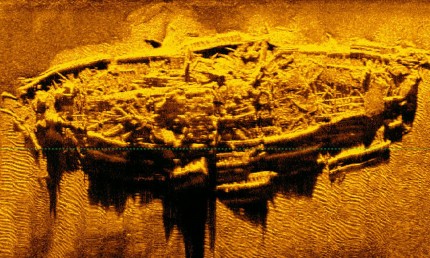The wreck of an iron-hulled Civil War steamer has been discovered off the coast of North Carolina near Oak Island. It was found on Saturday, February 27th, by researchers from the Underwater Archaeology Branch of the North Carolina Office of State Archaeology who were scanning the area with sonar. So far the complete hull of the 225-foot ship has been recorded and the study is ongoing.

The identity of the vessel has yet to be determined, but experts believe it is a blockade runner used to smuggle supplies and saleable goods through the Union naval cordon blocking the port of Wilmington. The wreck is 27 miles away from Wilmington near Fort Caswell which guarded the mouth of the Cape Fear River and played a key role, along with the blockade runners and Fort Fisher (which guarded the other inlet to the river), in keeping the port of Wilmington open longer than any other port in the Confederacy. It was open for virtually the entire war, in fact, until the Fort Fisher fell to a massive Union assault on January 15th, 1865.
The three likeliest candidates are blockade runners Agnes E. Fry, Spunkie and Georgianna McCaw, all of which were lost in the area. Agnes E. Fry is the front-runner because she was the largest of the three and her measurements come closest to matching those of the wreck. The Fry was built in Scotland in 1864 and renamed after the captain’s wife. Like all blockade runners, it was equipped with the fastest engines money could buy, fast enough to dodge Union ships on its way to and from the Caribbean. Havana, Cuba, was a frequent port of call for the Agnes E. Fry, and it may also have stopped at neutral ports in the British colonies of Bermuda and the Bahamas.
It’s been decades since a Civil War wreck has been found in the Oak Island area and researchers are particularly excited about this wreck because it appears to be in significantly better condition than past finds. The Cape Fear Civil War Shipwreck District covers 27 known wartime wrecks, blockade runners, Confederate ironclads and Union vessels, the greatest assemblage of Civil War ships known. However, the Atlantic off the coast of North Carolina is a very high-energy environment with a great deal of waves and sediment movement, so most shipwrecks are broken in pieces. Judging from the sonar image, this shipwreck looks almost intact.
As for why the wreck is in such good shape, [deputy state archaeologist Billy Ray] Morris said the change in dune patterns means that sand has helped prevent the vessel from wearing down over the decades.
“She was sanded over for most of the time she’s been laying on the bottom,” Morris said. “Now, the sand’s been scoured free.”
Even though the risk of blockade running was high — the Union captured 1,100 blockade runners and either destroyed and forced aground another 355 — profits were so huge companies were willing to take the chance. A single successful run could pay for the ship and then some. The Fry ran itself aground to avoid capture. The engines, paddle wheels and other useable part of the ship were salvaged at the time.
A dive team will be exploring the wreck starting Wednesday. Researchers are optimistic that they’ll be able to confirm which ship it is once they explore it in person. Any surviving cargo, artifacts or ship parts will only be disturbed if they are needed to answer questions about the vessel. It’s illegal for people to remove anything from these protected vessels, but tourist divers are welcome to explore with their eyes as long as they keep their hands to themselves.